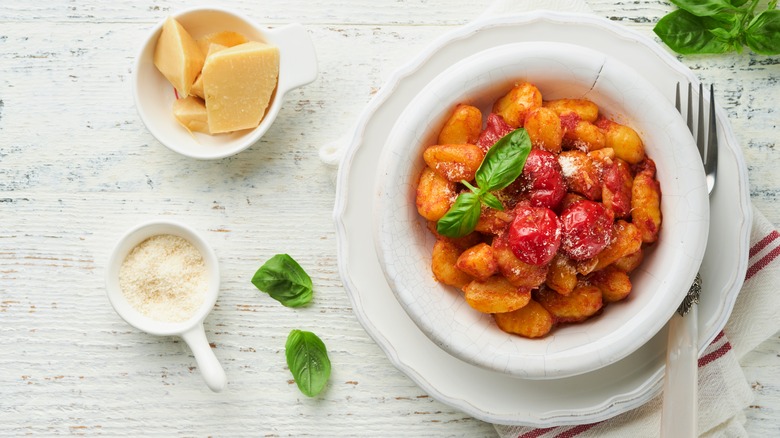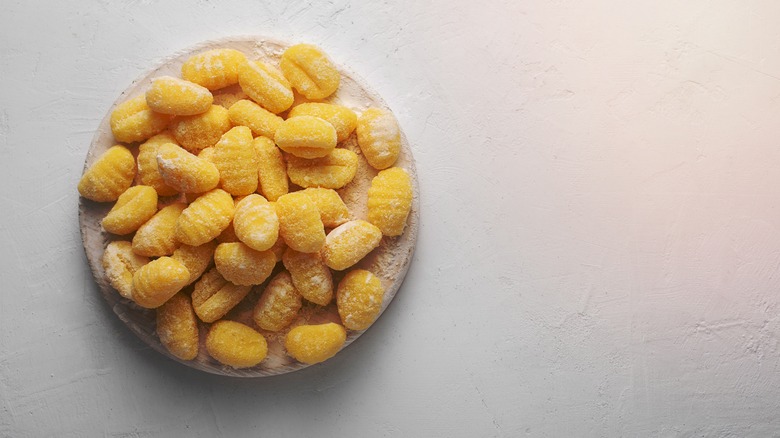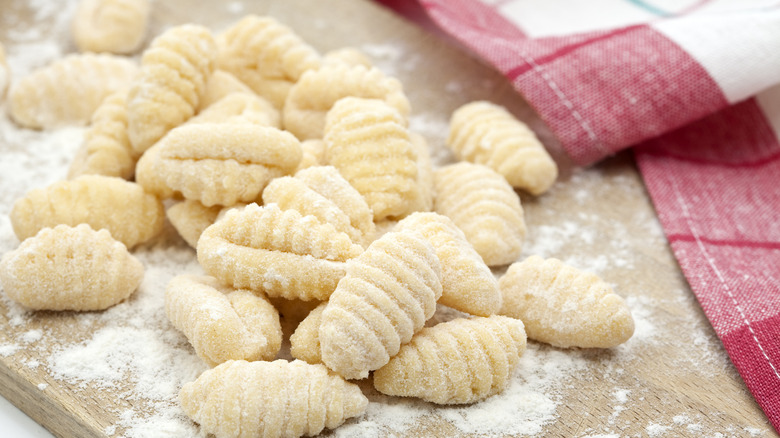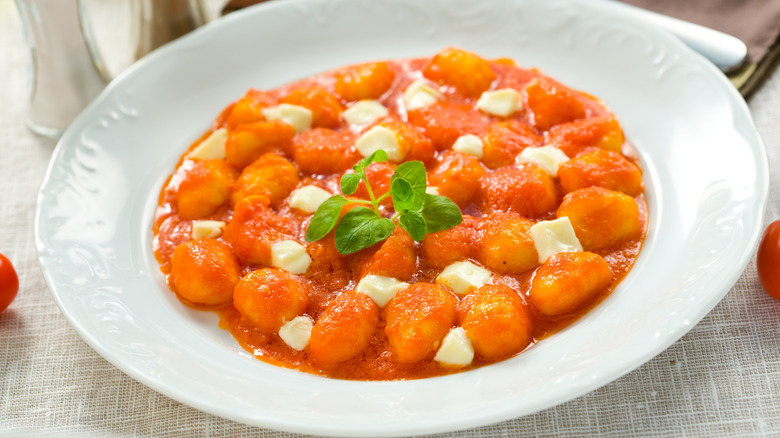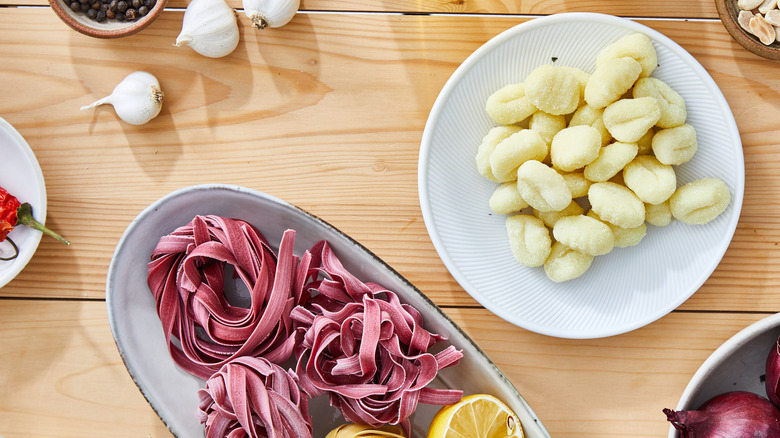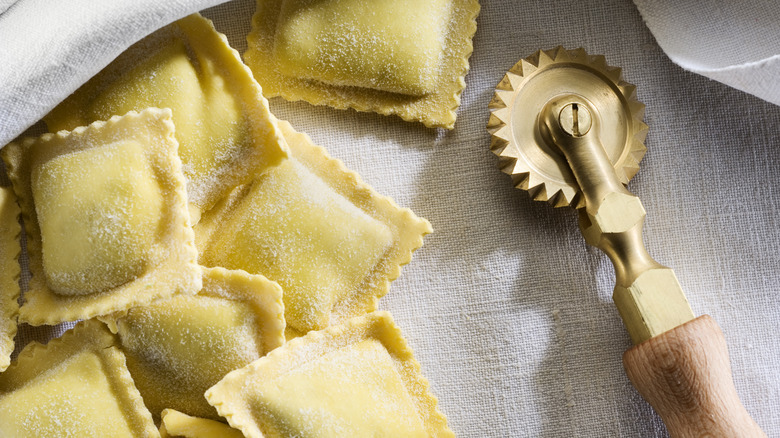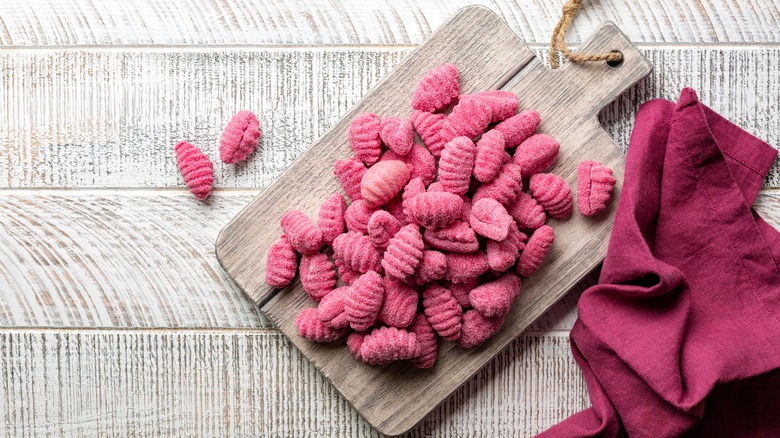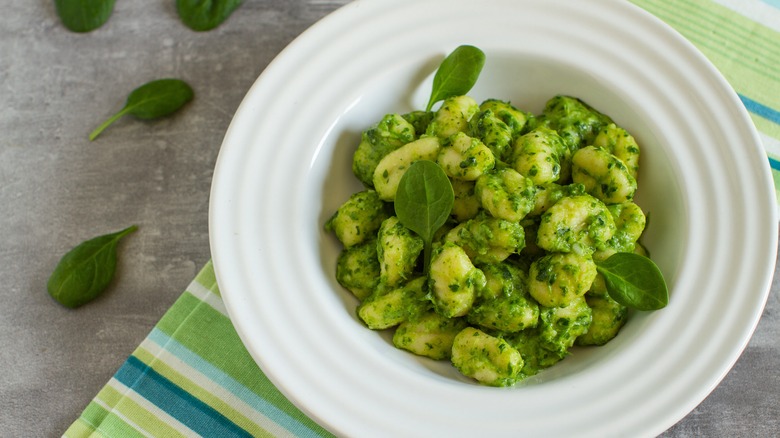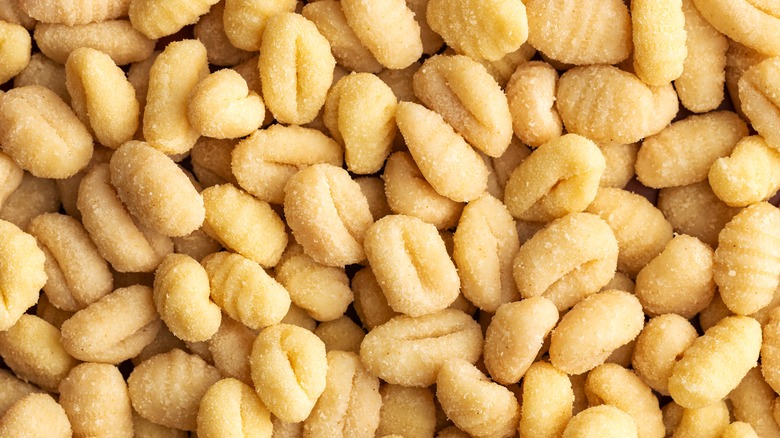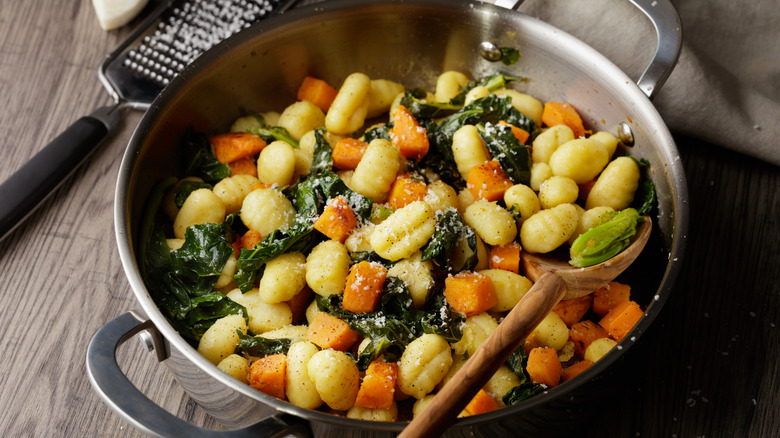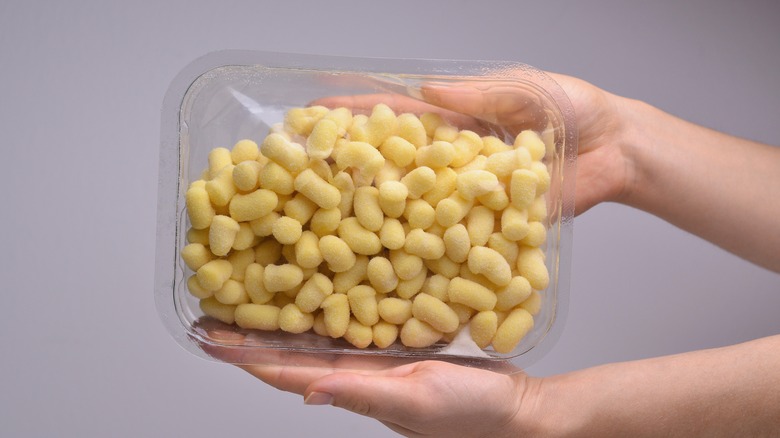What Is Gnocchi? And How Do You Cook It?
Traditional Italian food favorites, like pasta and pizza, get a lot of attention, but there is another classic Italian dish that doesn't get as much buzz: gnocchi. Gnocchi is potato dumplings served like pasta. The word itself is the plural form of gnocco, but you would never have just one gnocco so you only see the plural gnocchi on the menu. And to make it more confusing, there is a pasta called gnocchetti from the Italian island of Sardinia, but it's unrelated to potato gnocchi.
While gnocchi is a carbohydrate like pasta, it has no connection to pasta and is actually thought to predate pasta. Gnocchi has been linked to the Roman empire, and it is believed to have spread throughout ancient Rome by the Roman soldiers. But the gnocchi of the Romans only resemble today's gnocchi in shape because instead of potatoes, they used a mix of milk and flour to get that dumpling shape.
Today, gnocchi is a staple on the menu at Italian restaurants everywhere. It is versatile like pasta and can be served with classic Italian pasta sauces like marinara, pesto, or vodka sauce. If you are new to gnocchi, you will want to know everything about it so you can order it the next time you visit your favorite Italian eatery.
What is gnocchi?
Gnocchi is a small potato dumpling with a mild flavor, usually served covered in sauce. These little dumplings are an Italian specialty with a soft and chewy bite. The dish is popular all over Italy and has many regional variations. The classic potato gnocchi is the most well-known version but not the first version of gnocchi. Before the arrival of potatoes, which were introduced to Europe in the late 17th century, gnocchi was made with other ingredients. When potatoes were introduced, they became a staple crop in northern Italy, and the classic potato gnocchi was born.
The regional variations of gnocchi are diverse and range from savory to sweet. In the Piedmont region, gnocchi is made with chestnut flour and pumpkin. In Abruzzo, spinach is the star of gnocchi, and in South Tirol, gnocchi is made with bread and served in broth. Sweet gnocchi is popular in Fruili and is made with prunes, cinnamon, and stale bread.
Over in Tuscany, gnocchi is so popular that there are two different versions. One is made with spinach and ricotta called malfatti, which translates to badly made because this gnocchi looks more like little meatballs than classic gnocchi. And the other is a polenta-based gnocchi. In Rome, gnocchi is made into an au gratin and baked in butter. If you want to try these regional versions of gnocchi, you may have to travel to Italy because most Italian restaurants stick to the classic potato gnocchi.
How is gnocchi made?
Potato gnocchi is made with boiled potatoes and flour. The two are mashed together, creating a dough. Then, the dough is rolled into long ropes, and the pieces are cut and rolled on a gnocchi board to get those little ridges. To cook gnocchi, just add them to a pot of salted water. When they enter the water, they will sink. When they start to float to the top, they are ready. Gnocchi usually takes around three to four minutes to fully cook.
If you are making gnocchi at home and don't have a gnocchi board, you can use a fork to make those little ridges. You don't want to skip this step because the ridges aren't just decorative. They actually serve the purpose of holding the sauces, so you get a tasty bite of potato gnocchi and the sauce that it's served with.
Gnocchi seems like an easy dish to make at home, but it's challenging to get the right texture, and often, homemade gnocchi is too dense or sticks together in the cooking process. To avoid those common mistakes, use a starchy potato like Russett and stick to 00 flour, which is a finely ground flour that resembles baby powder.
What does gnocchi taste like?
Gnocchi is similar to pasta in that it has a neutral flavor. With gnocchi, the texture is more important than the flavor because it just takes on the sauce and seasonings, so it's difficult to make a bad-tasting gnocchi. But if gnocchi doesn't have the right light texture and instead is dense and gummy, it will ruin the whole dish.
The key to making homemade gnocchi and getting that texture just right is to make sure the ratio of potato to flour is correct and avoid over-kneading the dough. Gnocchi that has been over-kneaded or made with too much flour can be tough and rubbery. Getting homemade gnocchi just right may take a few tries, but once you get it, you will want to add it to your repertoire of dishes because it's so versatile. You can serve it on its own as a main dish, fry it in oil for a tasty appetizer, or add cooked gnocchi to soup for a light lunch.
Gnocchi vs. pasta
When it comes to gnocchi and pasta, they have some similarities and some key differences that make each unique. Let's start with the similarities: Both pasta and gnocchi are Italian staples served with sauce as a main course. Both can be made at home or found in stores, and both have a fairly neutral taste and make a filling meal. The differences lie in the ingredients: Gnocchi is made with potatoes, and pasta is made with semolina wheat flour. They cook differently, too; gnocchi cooks quickly in just three to four minutes, and pasta cooks closer to 10 minutes.
There is a misconception that gnocchi is a healthier version of pasta, but that isn't true. While they are made from different ingredients, they are both carb-heavy foods with minimal nutritional value. A cup of cooked pasta has 220 calories, and a cup of gnocchi has 250 calories. So, if you choose gnocchi instead of traditional pasta for health benefits, there really aren't any.
Gnocchi vs. stuffed pasta
Gnocchi and stuffed pasta look similar; they are both pillowy little puffs of flavor. However, gnocchi is all potato and flour, and stuffed pasta is filled with cheese, meat, or vegetables. Both can be served with sauce or in a soupy broth. And while traditional gnocchi is never stuffed, there is one regional variety of stuffed gnocchi in Piedmont in Northwest Italy.
While gnocchi and stuffed pasta are completely different from ingredients to taste, the thing they both share is that they come in various shapes and sizes. Stuffed pasta has many forms, like round tortellini, square ravioli, hat-shaped capelleti, and rectangle-shaped tortelli. And gnocchi has several different looks throughout Italy.
Gnocchi and stuffed pasta can both be made at home, but they aren't great recipes for beginner home cooks. Skills, like thinly rolling out homemade pasta and making dough from mashed potato and flour take some practice and are best left to experienced home cooks or professional chefs for best results.
Other ways to make gnocchi
Some creative chefs have started making healthier versions of gnocchi by replacing carb-heavy potatoes with other vegetables like cauliflower. Cauliflower is one of the most common potato replacements because when cauliflower is cooked and mashed, it resembles a potato, making it an easy choice for a healthier, low-carb version of everything from tater tots to French fries to gnocchi.
Some stores are even starting to carry premade cauliflower gnocchi. Winter squash, like butternut or pumpkin, is also a good choice to replace potatoes. Summer squash like zucchini and pattypan would work, too.
Another root vegetable getting in on the gnocchi trend is brightly colored beets. Beet gnocchi are purple and almost too pretty to eat. Vitamin-rich veggies like spinach, carrots, and sunchokes make deliciously gnocchi, too. There is a lot of wiggle room when it comes to gnocchi, so don't be afraid to get creative and try new ways of making it.
Ways to serve gnocchi
The classic way to serve gnocchi is to cover it in your favorite sauce and sprinkle it with parmesan cheese. But that isn't the only way to enjoy these dumplings. Instead of heavy sauce, you can pair gnocchi with olive oil and fresh herbs. Or mix them with roasted veggies. Or take a cue from another classic Italian dish, baked ziti, and mix gnocchi with sauce and cheese and bake into a casserole. Adding gnocchi to simple soups like a basic chicken broth turns it into a hearty meal. Or fry them in oil to get some crispy edges and serve with a dipping sauce, similar to fried ravioli.
Since the mild flavor of gnocchi mixes with just about anything, the best way to pair it is to think about texture and contrast. Soft, puffy gnocchi is excellent when mixed with crispy bits of guanciale or salty olives. Creamy goat cheese, pungent gorgonzola, and umami-rich mushrooms are great choices. Spicy chunks of andouille sausage and roasted red pepper give some depth to a simple plate of gnocchi.
Where to buy gnocchi
Most supermarkets sell packaged gnocchi near the other pastas. And some specialty shops may sell fresh gnocchi. Store-bought gnocchi varies in quality, and not all brands are created equal. You might have to try a few brands before you find the one with the best texture. International markets may have more choices and high-quality Italian brands. Online specialty stores are another excellent place to find quality gnocchi. You can also check with your favorite Italian eatery; some Italian restaurants may make gnocchi to sell to customers to make at home.
When buying store-bought gnocchi, you need to read the label. Potato gnocchi is surprisingly different than gnocchi made with potatoes; the former means the starchy tuber was the main ingredient, while the latter means flour was the key ingredient. If the package has dehydrated potatoes on the ingredient list, it is still a good option because dehydrated potatoes are the same as fresh potatoes in terms of nutrients and flavor.
Nutritional information for gnocchi
Gnocchi will vary depending on how it's made. Some versions of gnocchi use very little flour, and others have a ratio of 50% flour and 50% potato. The De Cecco brand gnocchi equates a single serving to 1 cup, which has 240 calories with 55 grams of carbohydrates, only 5 grams of protein, and 3 grams of fiber. The real kicker is that it has 620 milligrams of sodium per serving, which is almost half a daily serving of sodium in just 1 cup of gnocchi.
The American Heart Association recommends adults cap their sodium intake at 1,500 per day. So, while gnocchi is a filling meal, it doesn't have much nutritional value. One way to add more nutrients to gnocchi is to serve it mixed with sauteed vegetables or in homemade marinara with chunks of fresh tomatoes.
If you love gnocchi but want to avoid filling up on empty carbs, then lower-carb vegetable-based gnocchi, like cauliflower gnocchi, is a better choice. Or just save classic potato gnocchi for special occasions and enjoy it in moderation.
How to store gnocchi
Store-bought gnocchi are shelf-stable, but once opened, they should be stored in an airtight container in the refrigerator. It is best to store cooked gnocchi rather than uncooked because uncooked gnocchi loses its all-important texture in the refrigerator. When storing leftover cooked gnocchi, lay the pieces on a baking sheet so they are not touching. Cover them with plastic wrap or aluminum foil and use them within 48 hours. If you store cooked gnocchi covered in sauce, you can keep it in an airtight container in the refrigerator for three to four days, similar to leftover pasta.
Freshly made gnocchi is generally eaten on the same day. But if you are batch cooking and making a large portion of gnocchi, the best way to store them is to cook them first and then freeze them. Work in small batches, cooking the gnocchi, then lay them on a baking sheet covered in parchment paper. Let the cooked gnocchi cool to room temperature, then freeze them on the baking sheet. When frozen, put the cooked gnocchi in a sealable freezer bag and use within a month or two.
